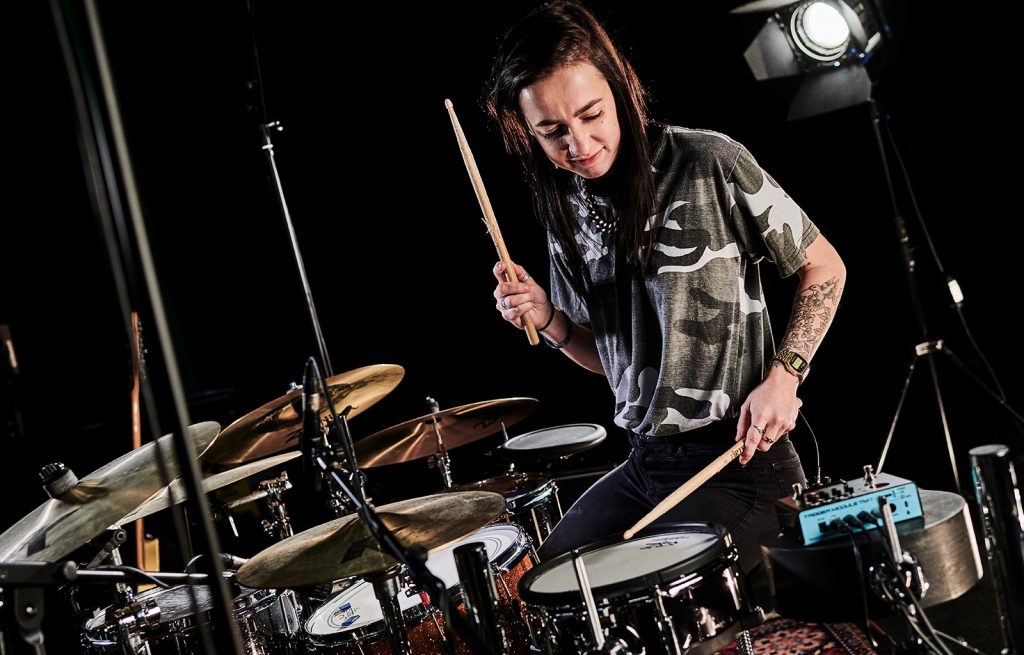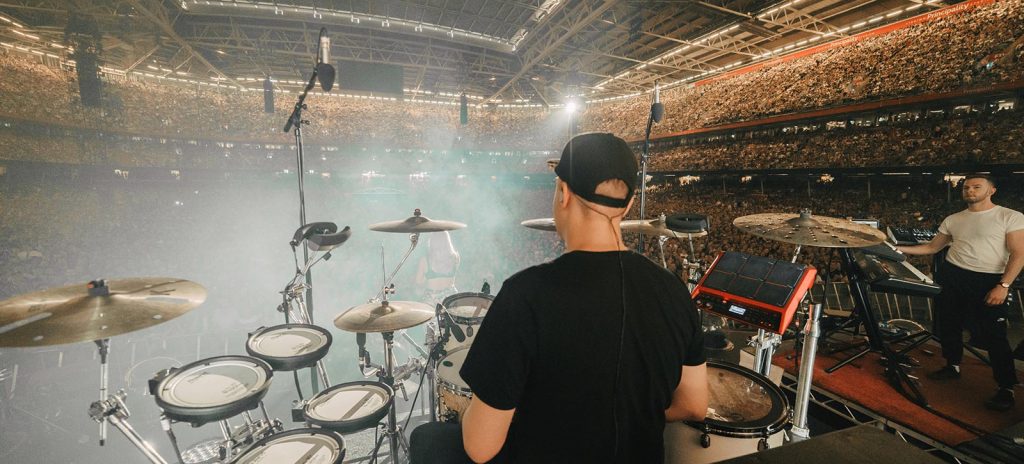The word hybrid is widely used in drumming circles. Still, the technology bringing acoustic and electronic drums together can feel reserved for those with Einstein minds, or drummers who play big stages with famous artists. However, this is far from the truth. If you think hybrid drums are out of your reach, you’re missing out on a hugely exciting movement that could enhance your drumming tenfold.
So, what are hybrid drums all about, and how can they benefit you as a drummer? Let’s dive in and find out.
Musical tastes are ever-expanding, playing styles are crossing over. Drummers no longer consider themselves just rock or pop players. Whether you’re a bedroom basher, a semi-pro drummer, or moving to the next level, your drumming set-up must be flexible and capable enough to deliver all the sounds your band or potential employer needs.
That’s where hybrid drums come in.

Hybrid Drums of the Past, Present, and Future
The concept of the hybrid drum kit—fusing acoustic and electronic drums into one versatile setup—has been around for decades. ’70s rock legends to modern-day pop session stars enhanced acoustic sounds and brought loops and samples into the mix.
Moreover, electronic percussion technology is advacing at a rapid rate. The hardware is easier to install and navigate. This means more drummers are including it in acoustic rigs to enhance live gigs and recordings. If you already own a drum module and an electronic trigger or pad, you’re well on your way to becoming a hybrid drummer.
There are three main applications for hybrid drums. We’ll take you through each approach

1: Enhance Acoustic Kit Sounds
A well-tuned acoustic drum kit can sound fantastic. Still, the overall sound is dependent on multiple factors, including the room you’re playing in and heads you’re using.
Introducing acoustic triggers and a sound module like the Roland TM-2 to your setup lets you blend electronic tonal elements with your acoustic sound. Ramp up the low-end of your kick, extract more attack from the toms, add some extra crack to your snare, and more. In short, you’ll have a consistent, full, clean drum sound every time.

2: Layer Acoustic and Electronic Sounds
Your acoustic drum kit remains at the core of your sound, but you can layer a second, full electronic sound on top via triggers and a module. The sound the module plays is entirely up to you. It could be a tambourine sample over your snare or a reverb-drenched kick sample that triggers every time you play your compact 18-inch kick.
In the “Hybrid Drum Battle” video below, Roland artists Michael Schack and Dirk Brand demonstrate how effective these approaches can be. They begin with acoustic kits, then electronic beats, before jamming through a mix of enhanced, expanded, and layered sounds.
3: Expand the Variety of Sound
Now and then a song needs a sound that you might not have in your acoustic arsenal. It might be something simple such as a cowbell or clave, a second snare or china cymbal, or something electronic like an 808 kick or vocal sample. A single electronic pad and module can solve all your problems. Pads open up a world of sonic possibilities to make you an indispensable drummer.
1: Enhance
Whether on stage, in the studio, or at home, drummers constantly search for ways to boost their acoustic drum sound. Ultimately, there’s only so much tweaking you can do before things start sounding unnatural. Fixes take up valuable time that could be spent drumming.
Whatever the issue, introducing basic electronic hardware enhances the core sound of your acoustic drums in any playing scenario.
At a basic level, a Roland RT-30K bass drum trigger and RT-30HR on your snare, connected to a Roland TM-2 trigger module, open up a host of tonal enhancement options. These can be blended with your acoustic sound. These tonal enhancements, referred to as Elements, are available onboard the module and from your samples via SD card.
Want more room-filling sub on the bass drum or attack on the toms? You got it. Need your snare to sound warmer or to cut through more? Consider it done. Your drums will still feel natural, but your kit as a whole will sound fuller and cleaner without compromising volume. Let’s see that in practice.
Trigger Warning
In this video, Michael Schack is using a Roland TM-2 Trigger Module with an RT-30HR Acoustic Drum Trigger connected to it. The trigger is attached securely to the rim of the snare drum.
When the snare is struck, the vibration from the drum head is detected by the trigger, sending a digital signal to the TM-2. The signal plays whichever sound the drummer has selected from the TM-2. In this case, the snare sound you hear is a sample of Michael’s acoustic drum. He recorded, mixed, and loaded it into the TM-2 via the onboard SD card slot.
The TM-2 output is then sent to the mixing desk, along with the kick drum microphone. Next, the engineer mixes the TM-2 and acoustic kick mic sounds together. Notice the significant difference when Michael briefly turns the TM-2 sound off then back on. The SPD-30 Octapad to the right is playing Michael’s backing music.
2: Layer
We’ve introduced you to the concept of enhancing your acoustic drum sound using triggers and mixing in additional tonal elements via a module. In addition, we’ve discussed expanding your drum sound options by incorporating electronic pads and a module into your setup. Now it’s time to delve into the world of layering.
Layering is a great way to further augment the sound of your acoustic setup. You’ll use the same electronic elements as if you were enhancing your acoustic sounds: triggers on the drums, connected to a module.
Rather than just blending subtle tonal elements into your acoustic sound, now we’re taking a full sample of a sound or drum and mixing it with your acoustic drum sound. This could be anything from an 808 snare drum, to handclaps, tambourine, or even a mixed sample of your kick, snare, and toms from your band’s latest demo.
Undercover Layers
Layering represents an amazing tool for gigging drummers, particularly if you play cover songs. You will always be limited by what you can achieve with a 20-inch kick drum or a 14×6 inch aluminum snare. Certainly, you won’t be able to recreate the drum sound of classic recordings crafted in multi-million-pound studios.
Layering means your trusty acoustic kit remains center-stage. At the same time, you can change your kick, snare, and toms from song to song.
The RT-MicS is the fastest way to enhance and reinforce the sound of your snare or tom. Incorporating both a microphone and trigger system with a sample playback engine, the RT-MicS is the first Roland hybrid acoustic and electronic drum product to capture a snare or tom and layer it with an electronic sound.

Sample the Goods
You’ll find plenty of high-quality samples onboard Roland’s modules to fit all styles of song. You can also sample drum sounds from original recordings (being respectful of copyrights, of course).
Layer those samples over the top of your acoustic sound and you’ll be as authentic as the originals. Imagine sounding like Blondie’s Clem Burke one minute, having the perfect Charlie Watts tone for “Brown Sugar” the next, before finally laying down some Daft Punk dance grooves. You’ll be consistent from gig to gig, regardless of venue acoustics or size. This attention to detail will place you and your band ahead of the game.
Layering Samples
In our video, Roland artists Michael Schack and Dirk Brand both play killer 30-second examples featuring acoustic sounds layered with full electronic samples. The results are striking. Michael has a Roland TM-2 with an RT-30K kick trigger and RT-30HR triggering snare drum head and rim independently. He’s layering a melodic note on the kick drum, a gated snare sound on the snare head, and a clap sound on the rim.
You’ll notice a couple of hits on the Octapad too, but he’s using that for additional sounds rather than for layering
3: Expand
Drummers can be like magpies, amassing vast collections of shiny things to bash. Sometimes, the sounds available from acoustic drums, cymbals, and percussion aren’t enough to meet a gig’s demands. Adding a few elements of electronic gear to your acoustic setup lightens the load and presents limitless options.
Expanding sounds with a hybrid setup is different than enhancing your existing acoustic sounds as we covered in our first video. When it comes to expanding, you’re not blending acoustic and electronic sounds using triggers and a module.
Thing Big, Start Small
Rather, you’re introducing small, independently placed pads, like the Roland BT-1 bar trigger or PD-8 Dual Trigger pad, to your acoustic kit and assigning any sound, texture, or backing tracks you want via a module. Your song might need a cowbell, a soaring vocal sample, or an 808 kick and snare in the verse. No problem, simply set up your pads and trigger away.
If you’d like to expand your sound options in a more stripped-back way, the SPD::ONE series aims to streamline setups further with a single pad trigger with an integrated sample engine. Coming in four dedicated varieties, the SPD::ONE series add plug-in and play sound additions to any kit setup.
Taking it to the next level, the Octapad or SPD-SX are convenient and powerful self-contained tools with onboard sounds and a large number of pads built-in, ready for you to play those sounds. The SPD-SX features nine pads and the option to add up to four auxiliary pads, plus the facility to create samples natively and introduce your sounds via USB.
Choosing Your Hybrid Sound Source
By now, you’ll hopefully be clear on the three concepts of “enhance,” “layer,” and “expand.” As a result, you’ll know which approach best suits your band and setup. Now, you just need to choose the right gear for the job. Whether you plan to beef up your acoustic kick, trigger samples, or stack sounds, it’s vital to choose a sound module that can deliver the goods.
Let’s say you’re in the enhance camp and looking to reinforce your acoustic drums with samples for in-your-face, finished production quality on stage. For that job, the TM-2 could be just the ticket. With two splittable/dual-trigger inputs for four separate trigger zones, you’ll see just how effective the TM-2 module can be.
Further Integration
Taking the TM-2 concept even further, the new TM-6 PRO allows integration of more triggers and pedals. It also includes a synchronized, multi-channel click and backing track audio streaming engine to serve as the centerpiece of a setup.
With its clear, back-lit screen and hands-on controls of all vital functions, the TM-6 PRO allows one to tweak while playing, even under dim stage lighting.
One of the most ubiquitous instruments for drummers and live performers is the SPD-SX Sampling Pad. Since the release of the first generation SPD-S sampling pads back in 2003, the tool continues to cross musical divides.
So you want to expand your setup and need to assemble a kit that can deliver the sounds in your head. With its powerful onboard tone and instrument libraries, the Roland SPD-30 Octapad has every sound you need
The Future of Drums is Now
Thanks to over 20 years of constant development, the TD-50 is the flagship module that brings all the trigger technologies together in one unit. The TD-50 boasts multi-channel, balanced audio outputs, and road-tested professional features.
There’s complete editability and a powerful effects engine connected via a wealth of analog and digital trigger inputs. Plus, it has a user sample load for layering and enhancing acoustic and electronic kits.








